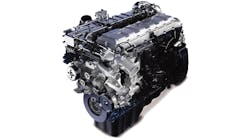Navistar International Corp. delivered a summary of the steps it will take as it introduces the In-Cylinder Technology Plus (ICT+) “clean engine” technology that will keep its Class 8 diesel engines in compliance with current U.S. Environmental Protection Agency standards for NOx emissions. In July Navistar said it would discontinue using the “exhaust gas recirculation” process for its products in favor of the more successful “selective catalytic reduction” (SCR) process.
The truck and heavy-duty engine builder engine builder will license Cummins Inc.’s urea-based after-treatment system and combine that process with its own advanced in-cylinder engine, to establish ICT+. The company intends to combine the Cummins' after-treatment system with its existing MaxxForce engines to meet 2010 EPA emissions regulations, and position it to meet greenhouse gas (GHG) rules in advance of 2014 and 2017 requirements.
"With this clean engine solution, we are taking the best of both technology paths to provide our customers with the cleanest and most fuel efficient engines and trucks on the market and to meet stringent U.S. emission regulations," stated president and CEO Daniel C. Ustian.
EGR recirculates part of a diesel engine's exhaust gas to the cylinders, where it replaces some excess oxygen prior to combustion. The EGR method that Navistar has used is one that EPA engineers originated and Navistar licensed, and then co-developed with EPA for commercial applications, but it has been ineffective at meeting the 2010 emissions standard. EPA ruled in February that the company would face non-compliance penalties of up to $2,000/day for each engine it sells that fails to meet the federal standard of 0.20 grams of nitrogen oxide per brake-horsepower hour.
Since then Navistar has been relying on earned emissions credits and paying the NCPs to maintain compliance, but in June a U.S. Court of Appeals ruled that Navistar can no longer pay NCPs for manufacturing non-compliant engines. The new combustion technology would overcome that setback, and if successful, settle its problem with EPA 2010 compliance.
As it implements the ICT+ technology, Navistar said it will continue to build and ship current model EPA-compliant trucks in all vehicle classes, using combinations of earned emissions credits and/or non-conformance penalties (NCPs), as appropriate.
Navistar said it continues “productive discussions” with the EPA and the California Air Resources Board (CARB) regarding the transition to ICT+.
Also, as part of an expanded relationship with Cummins, Navistar will offer the Cummins ISX15 engine in certain model trucks, expanding its vehicle lineup and on-highway market opportunity. Navistar said it would introduce the Cummins ISX15 engine in January 2013 as a part of its North American on-highway truck line. It will introduce ICT+ in its MaxxForce 13-liter in early 2013.
Finally, to support its transition plan and to improve its financial flexibility, Navistar has arranged a new senior secured-term loan for five years and $1 billion, with a group of banks that includes JPMorgan Chase Bank, N.A., Goldman Sachs Lending Partners LLC, Merrill Lynch, Pierce, Fenner & Smith Inc., and Credit Suisse. A portion of the proceeds from this loan will be used to pay existing loans.
"The actions announced today establish a clear path forward for Navistar and position the company to deliver a differentiated product to our customers and provide a platform for generating profitable growth," said Ustian.






